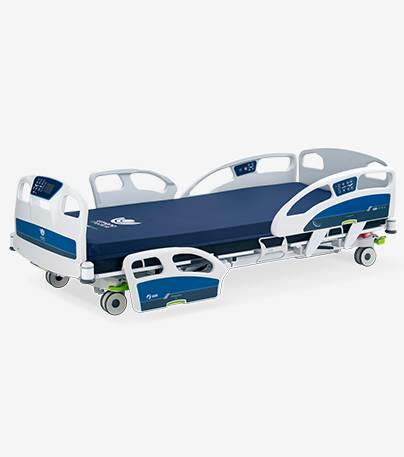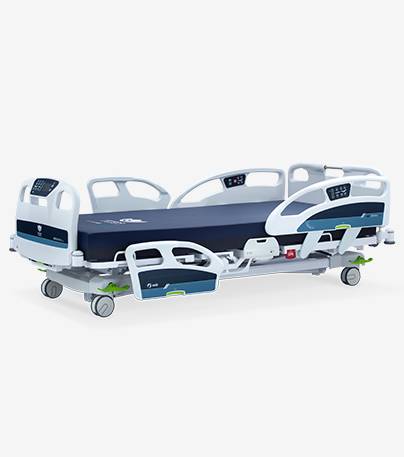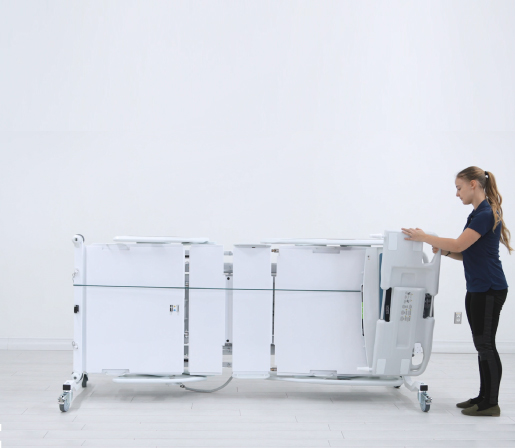
Addressing clinical and risk mitigation needs in behavioral health care environments when choosing a specialized bed

By Caroline Grimard
Product Manager
Published on May 25, 2023
The umbrella term “behavioral health” covers various behaviors and health issues. As a behavioral healthcare professional, you are undoubtedly aware that each care setting has different needs, as does each person living with a behavioral health condition. What do these different situations have in common? A need for compassionate, patient-focused environments where safety considerations have been thoughtfully weighed to provide the best possible clinical outcomes.
Beds are among the pieces of equipment in closest contact with your patient. This equipment can balance clinical and behavioral health benefits to ensure a dignified environment for your patient.
The following article introduces some key features you might want to consider when selecting specialized beds in environments where both clinical benefits and risk mitigation must be addressed.

Emergency Departments
The right specialized bed can support both the clinical and safety procedures your team applies daily in the emergency department (ED). As it is impossible to predict who will come through the ED doors or their condition, a versatile specialized bed could facilitate your clinical interventions while providing safety features.
For instance, look for clinically oriented features such as a cardiopulmonary resuscitation (CPR) release handle. Some patients could benefit from a low-height bed which helps lower fall risks. An integrated scale that enables you to weigh patients in any position can be another helpful characteristic.
Specialized beds can also offer features that help promote patients’ and care teams’ security in the emergency department. Tamperproof fasteners and hardware and permanently attached boards could help mitigate self-harm risks. You could also choose options like strategically located restraint points which would allow you to apply safety protocols if the situation demands it.
These bed characteristics can come together to assist your ED staff in addressing behavioral health as well as physical health conditions.
Geriatric Units
Specialized beds can also support healthcare teams in geriatric units. These professionals often have to monitor patients presenting comorbidities such as hypertension, diabetes, or cancer while addressing common behavioral health conditions in older patients. If your team works in a geriatric unit, they may want to favor beds that can support both behavioral and clinical aspects of their patients’ conditions.
Some beds may have intelligent features, such as monitoring capabilities and data management, which will support care interventions. A feature such as a bed exit detection system combined with a lower bed height may also help reduce the risk of falls. On the other hand, a built-in scale could be an asset to promote the safety of less mobile patients.
To allow you to focus on clinical care without having to perform multiple manipulations on your equipment, consider choosing a bed that offers one-touch clinical positions. An easy-to-clean bed can help you maintain clinical hygiene standards while minimizing the risk of spreading infections.
Care teams working in geriatric settings are also committed to ensuring the comfort and safety of their patients with behavioral health conditions such as dementia. Beds with solid siderails that do not have openings may help increase the sense of security for these patients. Master locks and tamperproof brakes could also play a role in preventing unwanted bed movement.
While considering appropriate beds for geriatric settings, you might also look for specialized beds offered in subdued, soothing colors, such as white or gray, rather than brighter colors.
Detention Centers
Management of both physical and behavioral health is also a challenge faced by detention centers. Statistics and studies show that “[m]ore than half of [people incarcerated] have a mental health problem, a substance use disorder, or both, and they experience higher rates of geriatric conditions than the age-matched general population1.”
Under these conditions, healthcare teams working in detention centers must face various situations. A specialized bed could facilitate their interventions if your team works in such a facility. Depending on the intended clinical use, such beds may have different features and options. For example, a bed used for infirmary-level care may require more care functionalities and features, such as an integrated scale or a patient positioning system, as one used in inmate rooms.
In detention centers, it is also essential for beds to present key safety features. For example, a tamper-resistant and ligature-resistant design could contribute to reducing self-harm risks. These beds can also have concealed cables and attached boards to prevent a person from using them harmfully. As previously discussed, the bed can be securely held in place by a tamperproof brake system or bolted to the floor. For optimal security, a one-piece platform bed can be considered. Since they are durable and impact-resistant, those types of beds are often chosen for increasing safety in inmate rooms. A medical bed with no side rails can also represent the right compromise between a fully equipped bed and a platform bed.

Dedicated Psychiatric Units
High-observation facilities admit patients with a variety of behavioral health symptoms and disorders. While addressing the needs associated with these conditions, teams working in such facilities always seek to provide a high level of clinical care to their patients. Depending on their patient population, some behavioral health centers or psychiatric units may benefit from a bed that offers clinical functionality and safety options.
A patient in severe psychological distress or experiencing an episode of psychosis may need to be protected from self-harming attempts. Consider a low height lockable bed that promotes patient safety while offering clinical benefits. A ligature-reducing or tamper-resistant design could also contribute to minimizing self-harming behaviors.
Specialty beds can also offer more secure and resilient components to prevent patients from engaging in self-harming behaviors. Features like password protection and motion locks can also help prevent unwanted maneuvers. Additional restraint points used strategically will allow you to implement safety protocols when necessary to keep your patients and your team safe.
Intelligent monitoring features could also support your team on both clinical and safety levels.
Conclusion
While each behavioral healthcare setting presents its own clinical and risk reduction challenges, they all share the same concern for creating and maintaining safe, compassionate, patient-centered environments. The various options presented in this article are just a starting point to help you determine how the appropriate bed can address the specific needs of your care setting. Since your healthcare setting and your patient population may change over time, adaptability is essential to look for in this type of equipment.
As you apply your clinical and safety protocols, well-chosen equipment will become your ally throughout your workday. At Umano Medical, we strive to help you find the right balance between risk reduction and clinical benefit. Try exploring our bed options, such as our ook snow MH bed for behavioral health or the Max-Secure platform bed. You may better understand what configuration of features could help you and your team in your daily work.
1Alsan, Marcella, Yang, Crystal S., Jolin, James R., Tu, Lucy, Rich, Josiah D., "Health Care in U.S. Correctional Facilities — A Limited and Threatened Constitutional Right," New England Journal of Medicine March 2, 2023, 388 (9):847, 19 April 2023 <https://www.nejm.org/doi/full/10.1056/NEJMms2211252 >
Citing:
Puglisi, Lisa B., and Emily A. Wang. "Health care for people who are incarcerated." Nature Reviews Disease Primers 7.1 (2021): 50.
And Greene, Meredith, et al. "Older adults in jail: high rates and early onset of geriatric conditions." Health & justice 6 (2018): 1–9.
About the author

Caroline Grimard
More articles form Caroline Grimard

Headquarters
230 boulevard Nilus-Leclerc
L'Islet, QC G0R 2C0
CANADA
1 844 409-4030
Lévis Office
470 3e Avenue
Lévis, QC G6W 5M6
CANADA
US Location
11845 Adie Road
Maryland Heights, MO 63043
UNITED STATES
Careers
Our talented and passionate team is determined to revolutionize the medical industry. Be part of the journey: join the Umano Experience.
See available jobsConnect with us
Copyright © 2024 Umano Medical inc







